- Claims that wind and solar power are cheaper to produce are not credible.
- Without hydrocarbons and nuclear there are no benefits and only costs to Smart Meters, meaning increased scarcity and energy poverty.
- Dynamic pricing only leads to increased scarcity and energy poverty.
Critics of green policy have argued that renewable energy is a departure from the understanding that society and a robust economy requires energy to be abundant, reliable and affordable. After many years of experimental green policy throughout Europe, there exists a good case that renewable energy has created energy scarcity, unreliability and increased costs.
Advocates have claimed in reply that renewable energy is now cheaper than conventional power production. However, these claims are based on bids (known as ‘strike prices’) made by renewable operators through the UK’s complex market mechanism of Contracts for Difference (CfDs). Low bids have been offered for a number of years, causing green advocates to claim that offshore wind power is now cheaper than electricity produced from natural gas. But at the time of writing, no electricity has been traded on the grid at the rates implied by these bids.
Moreover, there exists no evidence that offshore wind farm developers have been able to reduce their costs, enabling them to make such low offers, and offshore wind farms do not seem to have gotten cheaper to develop. And even were wind farms able to deliver electricity at prices lower than power from hydrocarbon-fired generators, the variability of weather creates scarcity that needs to be dealt with by backup supply (balancing and baseload), adding system cost (greater expense) to the price paid by consumers.
Because of renewable energy’s shortcomings, a range of solutions have been developed. Smart grids and smart meters have been proposed, which can function either to turn energy intensive devices off to reduce the load on the grid (e.g. electric vehicle chargers), or allow the consumer to choose when to operate appliances, based on real-time price data. For instance, politicians have claimed that time-of-day pricing would allow consumers to take advantage of lower prices when there is a greater amount of power available on the grid and the price is therefore lower. But notice the implication of a serious downside in this emphasis on the upside: affordable energy may not be available to the consumer when it is required.
The attractive term ‘smart meter’ therefore belies the reality that what it actually delivers to the consumer is rationing. For poorer households, this means that rather than energy being available when they need it, they will have to organise their lives around the availability (or not) of affordable energy on the grid. Put simply, this means some people will find that they can’t afford to shower before work, and heating their home will be unavailable or overly costly when it is most needed. Weather-dependent energy means precisely that people once again, like their ancestors, will be dependent on the weather, and unable to make their own plans.
Similarly, ‘dynamic pricing’ is a misleading term which obscures the reality of consumers being unable to plan their lives according to predictable costs of electricity. According to its advocates, smart meters will allow consumers to take advantage of cheaper energy when there is an abundance of energy on the grid. This is superficially similar to energy supply contracts that have been available to consumers for many years, known in the UK as ‘Economy 7’. To help generators and grid operators reduce the variability of demand versus supply, suppliers offered cheaper energy during times of lower demand. Consumers who took advantage of this scheme had two meters installed, one which recorded energy use during peak (daytime, and more expensive) hours and another which recorded energy use during off-peak (night-time and cheaper) hours. This enabled households to use the excess electricity on the grid to heat hot water storage tanks for use the following day, and to keep their homes warm.
But rather than bringing this system up to date, so called smart meters (electronic energy use monitors), in combination with renewable energy, in fact destroy the possibility of schemes such as Economy 7. Alongside the UK’s smart meters and wind farms, it is expected that the UK will significantly expand its fleet of electric vehicles, and the government has announced investment in green hydrogen. These applications will remove any excess electricity from the grid, meaning that there will not be times of low demand to enable less wealthy consumers to take advantage of lower prices. This is a radical departure from the past, in which different applications were supplied by different fuel sources. Cars were powered by petrol and diesel; homes were heated by gas; and baseload electricity was generated from coal and nuclear, while gas generators followed changes in demand. Following the implementation of the policy agenda of ‘the electrification of everything’ (especially without nuclear), these different applications will be competing for the same resource.
